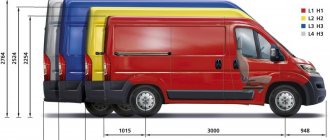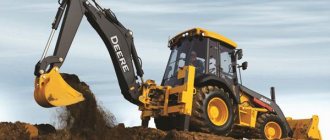The PR-F-145 roll baler, which will be discussed, is a machine adapted for collecting and pressing: hay, grass, straw into rolls. There are many models on the agricultural machinery market that differ in their operating principle and pressing method. The diameter of the final product – the roll – depends on this. For further transportation and convenient storage, the rolls are wrapped with twine or a mesh designed for this purpose. Then they are placed in a polymer film.
This allows you to significantly reduce processing time, reduce the technological process and costs associated with the preparation of feed for livestock.
Specifications
The baler moves on a wheeled chassis and uses diesel fuel to operate.
Tractor used in technical connection – from 1400 kg and above. Read more about the characteristics in Table 1. Table 1 - Technical characteristics of the PR-F-145 baler
| Model | PR-F-145 |
| Working width, m | 1,45 |
| Overall dimensions, m | |
| length | 3,95 |
| width | 2,3 |
| height | 2,4 |
| Roll length, cm | 120 |
| Roll diameter, cm | 145 |
| Roll weight, max, kg | |
| in the hay | 220 — 375 |
| on the straw | 150 — 250 |
| Machine weight, t | 1,9 |
| Tractor, class. t.s. | 1,4 |
Tractor DT 75: description, technical characteristics, photos, application.
Read the description of a rotary mower for a walk-behind tractor here.
Decree of the Government of the Russian Federation dated 02/08/2017 No. 145
Approved by Decree of the Government of the Russian Federation of February 8, 2022 No. 145
1. These Rules determine the procedure for creating and maintaining a catalog of goods, works, and services to meet state and municipal needs, including the composition of the information included in it.
2. The catalog of goods, works, and services to meet state and municipal needs (hereinafter referred to as the catalog) means a systematic list of goods, works, and services purchased to meet state and municipal needs, formed on the basis of the All-Russian Classifier of Products by Type of Economic Activities (OKPD2) OK 034-2014 and including information in accordance with these Rules.
(Clause as amended, put into effect on October 9, 2022 by Decree of the Government of the Russian Federation of October 6, 2017 No. 1217. - See previous edition.)
3. The formation and maintenance of the catalog is carried out in a unified information system in the field of procurement, including through information interaction with other information systems in cases established by the legislation of the Russian Federation on the contract system in the field of procurement of goods, works, services to meet state and municipal needs, as well as information systems maintained by authorized federal executive authorities.
(Clause as amended, put into effect on October 9, 2022 by Decree of the Government of the Russian Federation of October 6, 2017 No. 1217. - See previous edition.)
4. The formation and maintenance of the catalog is ensured by the federal executive body for regulating the contract system in the field of procurement (hereinafter referred to as the authorized body), including as a result of interaction with the federal executive bodies responsible for the formation and (or) maintenance of information systems, as well as those carrying out state registration of goods in the established field of activity, through:
(Paragraph as amended, put into effect on October 9, 2022 by Decree of the Government of the Russian Federation of October 6, 2017 No. 1217. - See previous edition.)
a) generating information included in the catalog in accordance with these Rules;
b) keeping the catalog up to date;
c) information support for catalog users.
(Subclause as amended, put into effect on October 9, 2022 by Decree of the Government of the Russian Federation dated October 6, 2017 No. 1217. - See previous edition.)
4.1. For the purpose of information interaction provided for in paragraph 3 of these Rules, the authorized body establishes the composition, procedure for sending and signing the information provided for in subparagraphs “b” - “d” of paragraph 10 and specified in subparagraph “b” of paragraph 14 of these Rules, by federal executive authorities, carrying out the formation and (or) maintenance of relevant information systems, as well as state registration of goods in the established field of activity.
(The paragraph was additionally included from April 24, 2022 by Decree of the Government of the Russian Federation of April 12, 2018 No. 444.)
5. For the purpose of ensuring the formation and maintenance of the catalogue, the authorized body has the right, in accordance with the legislation of the Russian Federation, to engage a legal entity that is the operator of the catalogue.
6. The catalog must be publicly available 24 hours a day for review and use without charging a fee.
7. The catalog does not include information that constitutes a state secret.
8. The catalog is maintained in Russian. In cases provided for by federal laws and regulations adopted in accordance with them, information may be included in the catalog using letters of the Latin alphabet.
9. The catalog is formed and maintained in electronic form. The catalog position is formed in accordance with paragraph 10 of these Rules.
(Clause as amended, put into effect on October 9, 2022 by Decree of the Government of the Russian Federation of October 6, 2017 No. 1217. - See previous edition.)
10. The following information is included in the catalog item:
a) catalog item code generated in accordance with paragraph 12 of these Rules;
(Subclause as amended, put into effect on October 9, 2022 by Decree of the Government of the Russian Federation dated October 6, 2017 No. 1217. - See previous edition.)
b) name of the product, work, service (for the purposes of these Rules, the name of the product, work, service is understood as the name of the corresponding product, work, service included in the catalog position, which is not a trade name and does not contain an indication of a specific manufacturer and (or) place origin of the goods);
c) units of measurement of the quantity of goods, the volume of work performed, services provided in accordance with the All-Russian Classifier of Units of Measurement OK 015-94 (OKEY) (if available);
(Subclause as amended, put into effect on October 9, 2022 by Decree of the Government of the Russian Federation dated October 6, 2017 No. 1217. - See previous edition.)
d) information containing a description of a product, work, service, if such a description is formed in accordance with paragraph 13 of these Rules;
(Subclause as amended, put into effect on October 9, 2022 by Decree of the Government of the Russian Federation dated October 6, 2017 No. 1217. - See previous edition.)
e) background information:
codes corresponding to the product, work, service in accordance with Russian and international classification and cataloging systems (if available);
(Paragraph as amended, put into effect on October 9, 2022 by Decree of the Government of the Russian Federation of October 6, 2017 No. 1217. - See previous edition.)
information on standard contracts, standard contract terms to be applied when purchasing goods, work, services (if available);
f) date of inclusion in the catalog of the item;
(Subclause as amended, put into effect on October 9, 2022 by Decree of the Government of the Russian Federation dated October 6, 2017 No. 1217. - See previous edition.)
g) date(s) of the beginning of mandatory application of the information included in the catalog item;
(Subclause as amended, put into effect on October 9, 2022 by Decree of the Government of the Russian Federation dated October 6, 2017 No. 1217. - See previous edition.)
h) expiration date for the catalog item (if necessary);
(Subclause as amended, put into effect on October 9, 2022 by Decree of the Government of the Russian Federation dated October 6, 2017 No. 1217. - See previous edition.)
i) additional information in accordance with paragraph 19 of these Rules.
11. The clause has lost force since October 9, 2022 - Decree of the Government of the Russian Federation of October 6, 2022 No. 1217. - See the previous edition.
12. The catalog item code is generated for each catalog item and is a unique digital code based on the code of the All-Russian Classifier of Products by Type of Economic Activities (OKPD2) OK 034-2014.
(Clause as amended, put into effect on October 9, 2022 by Decree of the Government of the Russian Federation of October 6, 2017 No. 1217. - See previous edition.)
13. The description of goods, work, services in accordance with the requirements of Article 33 of the Federal Law “On the contract system in the field of procurement of goods, works, services to meet state and municipal needs” (hereinafter referred to as the Federal Law) includes the following information:
a) consumer properties and other characteristics of goods, work, services, including functional, technical, quality characteristics, operational characteristics (if necessary), formed taking into account the following information:
(Paragraph as amended, put into effect on October 9, 2022 by Decree of the Government of the Russian Federation of October 6, 2017 No. 1217. - See previous edition.)
if the specified characteristics have a quantitative assessment, then units of measurement are used in accordance with OKEI. If there is no unit of measurement in the OKEI, in respect of which the authorized body has decided to include in the description of a product, work, or service, the authorized body sends to the federal executive body ensuring the development, maintenance and application of the OKEI, an appeal for inclusion of such a unit of measurement in the OKEI. In this case, before the inclusion of the corresponding unit of measurement in the OKEI, such a unit of measurement is included in the description of the product, work, service and is considered a temporary value;
(Paragraph as amended, put into effect on April 24, 2022 by Decree of the Government of the Russian Federation dated April 12, 2018 No. 444. - See previous edition.)
in relation to each characteristic that has a quantitative assessment, its specific value, or an exhaustive list of specific values, or ranges of acceptable values (minimum or maximum acceptable values), or unchangeable values, including taking into account the requirements for a product, work, service, established in accordance with Article 19 of the Federal Law;
(Paragraph as amended, put into effect on October 9, 2022 by Decree of the Government of the Russian Federation of October 6, 2017 No. 1217. - See previous edition.)
in relation to each characteristic that does not have a quantitative assessment, an exhaustive list of the relevant properties of the product, work, service is indicated, including taking into account the requirements for procurement objects established in accordance with Article 19 of the Federal Law;
b) information on technical regulations applicable to goods, works, services, adopted in accordance with the legislation of the Russian Federation on technical regulation (if any), documents developed and applied in the national standardization system, adopted in accordance with the legislation of the Russian Federation on standardization (if any) availability);
(Subclause as amended, put into effect on April 24, 2022 by Decree of the Government of the Russian Federation dated April 12, 2018 No. 444. – See previous edition.)
c) if necessary, specifications, plans, drawings, sketches, photographs, digital models, results of work, testing, requirements, including with regard to testing, test methods, packaging in accordance with the requirements of the Civil Code of the Russian Federation, markings, labels, confirmation compliance of processes and production methods in accordance with the requirements of technical regulations, standards, technical specifications, as well as in relation to symbols and terminology;
d) the subclause has lost force since October 9, 2022 - Decree of the Government of the Russian Federation of October 6, 2022 No. 1217 - see the previous edition.
14. Catalog items are formed and included in the catalog in the following order:
a) the formation and inclusion in the catalog of information provided for in subparagraphs “a” and “e” of paragraph 10 of these Rules is ensured by the authorized body automatically using software and hardware;
(Subclause as amended, put into effect on October 9, 2022 by Decree of the Government of the Russian Federation dated October 6, 2017 No. 1217. - See previous edition.)
b) the information provided for in subparagraphs “b” - “e” of paragraph 10 of these Rules is included in the catalog by the authorized body on the basis of information provided, inter alia, by federal executive authorities responsible for the formation and (or) maintenance of relevant information systems, as well as state registration of goods in the established field of activity, regional information systems in the field of procurement, operators of other information systems in cases established by the legislation of the Russian Federation and other regulatory legal acts on the contract system in the field of procurement of goods, works, services to meet state and municipal needs. In this case, the information provided for in subparagraph “d” of paragraph 10 of these Rules is included in the catalog after agreement with the Federal Antimonopoly Service;
(Subclause as amended, put into effect on April 24, 2022 by Decree of the Government of the Russian Federation dated April 12, 2018 No. 444. – See previous edition.)
c) the information provided for in subparagraphs “g” – “h” of paragraph 10 of these Rules is generated by the authorized body taking into account the requirements of paragraph 18 of these Rules;
(Subclause as amended, put into effect on October 9, 2022 by Decree of the Government of the Russian Federation dated October 6, 2017 No. 1217. - See previous edition.)
d) the information provided for in subparagraph “i” of paragraph 10 of these Rules is included in the catalog in accordance with paragraph 19 of these Rules.
15. The information specified in paragraph 10 of these Rules, including before its inclusion in the catalog position, is considered at a meeting of the expert council for the formation and maintenance of a catalog of goods, works, services to meet state and municipal needs under the authorized body. The regulations on the expert council for the formation and maintenance of a catalog of goods, works, services to meet state and municipal needs and its composition are approved by the authorized body.
(Clause as amended, put into effect on April 24, 2022 by Decree of the Government of the Russian Federation dated April 12, 2018 No. 444. - See previous edition.)
16. Information included in the catalog, with the exception of information provided for in subparagraphs “a” and “e” of paragraph 10 of these Rules, must be signed with an electronic signature of an authorized official (persons) determined by the authorized body or the catalog operator (in the case its involvement for the purpose of ensuring the formation and maintenance of the catalog in accordance with paragraph 5 of these Rules), the type of which is provided for by Federal Law.
(Clause as amended, put into effect on October 9, 2022 by Decree of the Government of the Russian Federation of October 6, 2017 No. 1217. - See previous edition.)
17. Keeping the catalog up to date is carried out by making changes to it in the manner prescribed by paragraphs 14 and 15 of these Rules, and by generating and entering information containing relevant changes into the catalog by the authorized body.
(Clause as amended, put into effect on April 24, 2022 by Decree of the Government of the Russian Federation dated April 12, 2018 No. 444. - See previous edition.)
18. Information included in a catalog item in accordance with subparagraph “a” of clause 10 of these Rules is subject to application from the day a new catalog item is included in the catalog. In this case, the start date of the mandatory application of information provided for in subparagraphs “b” - “i” of paragraph 10 of these Rules is set after 30 days from the date of inclusion of a new catalog item in the catalog, unless otherwise established by the authorized body.
(Clause as amended, put into effect on October 9, 2022 by Decree of the Government of the Russian Federation of October 6, 2017 No. 1217. - See previous edition.)
19. Catalog items in accordance with Article 33 of the Federal Law may include additional information about specific goods, works, services, including information about the characteristics of such goods, their manufacturers, trade names, names of places of origin of goods, prices per unit quantity of goods, volume of work, services and (or) prices per unit of measurement of the quantity of goods, volume of work, services, conditions for the supply of goods, performance of work, provision of services. This information is generated, among other things, by manufacturers and (or) suppliers (contractors, performers). The grounds and procedure for the formation and inclusion of such information in the catalog are determined by the authorized body in agreement with the Federal Antimonopoly Service.
Principle of operation
The design uses a special chamber of a closed chain-slat type for pressing raw materials. There is an uninterrupted supply of twine for tying using an electric drive.
The PR-F-145 round picker performs work in several stages:
- collection of rolls of raw materials (hay);
- the process of pressing into rolls of a certain size;
- trouble-free twine tying using an electric drive.
The rolls are pressed tightly and this allows them to be packaged in polymer film. All rolls are well formed in a certain way. The upper part of the product is denser, but the inside structure is loose. This allows the roll not to deteriorate and reduces the likelihood of mold.
The operating instructions can be downloaded from this link.
Economic efficiency
Any technical or technological advantages to a certain extent affect the economics of the enterprise. Let's define each advantage in monetary terms.
1.Losses during loading and transportation.
When using a silage harvester to make alfalfa silage, approximately 6% of the green mass is lost compared to a baler. As you know, leaf mass is protein.
Let's do the calculation for our example. From 300 hectares with a yield of 20−25 t/ha (for all cuttings), we collect approximately 6,000 tons of fresh mass (4,080 tons in test weight). So, the annual loss after the combine and trucks is approximately 360 tons of alfalfa silage per year, which in terms of dry matter is 126 tons.
With a protein content of 20% in dry matter, the loss is 25.2 tons of protein per year. This amount of protein would yield approximately 1000 liters of milk/ha! In terms of the entire area of alfalfa, 303.6 tons of milk/year remain on the field, which in monetary terms, even at today’s milk price, is more than 100 thousand euros!
Owner reviews
All owners of the PR-F-145 baler talk about the quality of the final product. Consequently, the equipment is reliable and capable of dispensing compressed animal feed. This production method facilitates the harvesting process by reducing work time, which is important when weather conditions change, which may interfere with the harvesting process. They talk about the simplicity of the design and reasonable price of the baler.
Read about test report No. 013309 (4130162) for the PR-F-145 baler by clicking on the link.
Description of the rapeseed table: effectiveness of application.
You can get acquainted with the types of Case combines in this article.
Types of do-it-yourself walk-behind mowers here.
Feed quality
How exactly does the PRF-145 baler affect the quality of feed? Firstly, and this is the most important thing, during the preparation of silage from alfalfa using a baler, the leaf mass is not lost - it is not blown away by the wind under load, and the main proportion of the protein in alfalfa is contained in the leaves.
Secondly, the cutting length of green mass is 4-6 cm, fully meeting the needs of ruminants . Shorter cutting, according to recent research by British scientists, causes active loss of dry matter during storage.
Of course, these statements could be questioned if it were not for the results of analyzes of alfalfa silage made on domestic farms that use various technologies for the preparation of roughage.
So, this year, even the workers of the Austrian laboratory “Rosenau”, who analyzed domestic feed, were pleasantly surprised that one of the farms received 100 points out of 100 possible for the quality of alfalfa silage. This farm uses a baler to make grass silage.
As the results of the analysis show, alfalfa silage is characterized not only by a high protein and energy content, but also by a correct fermentation process , which directly affects the taste of the feed and, accordingly, the amount of its consumption.
Due to complex actions, including feeding such silage, the farm managed to increase milk yield per milking cow by 26%. Today, the farm receives 24-25 liters of milk from a cow per day compared to last year’s 18 liters. At the same time, the share of concentrated feed in the diet did not change.







